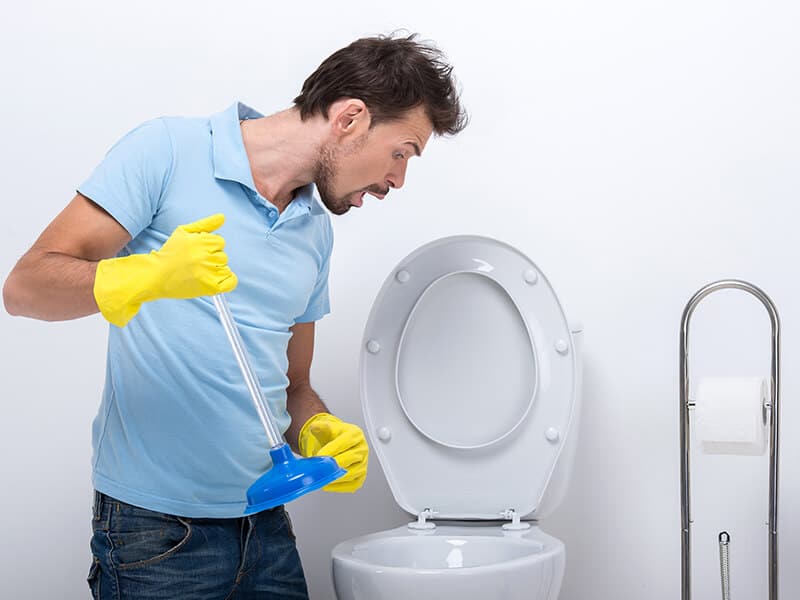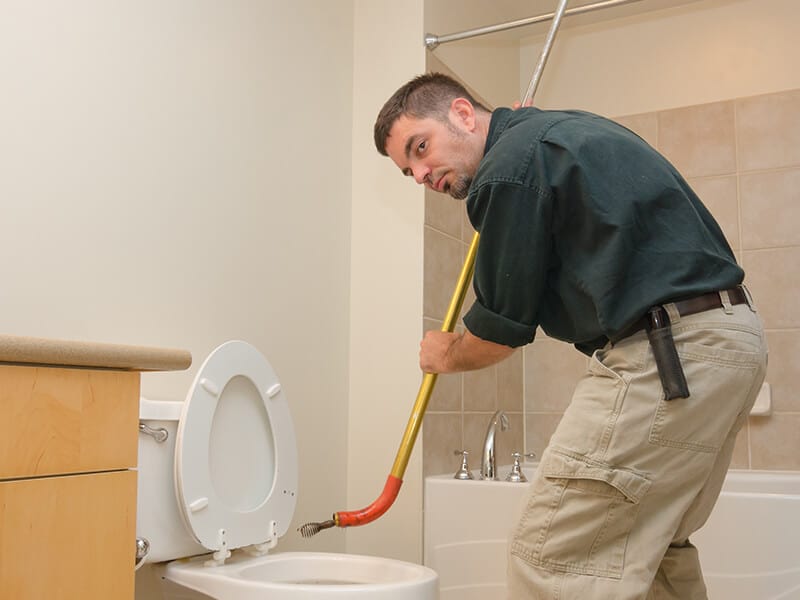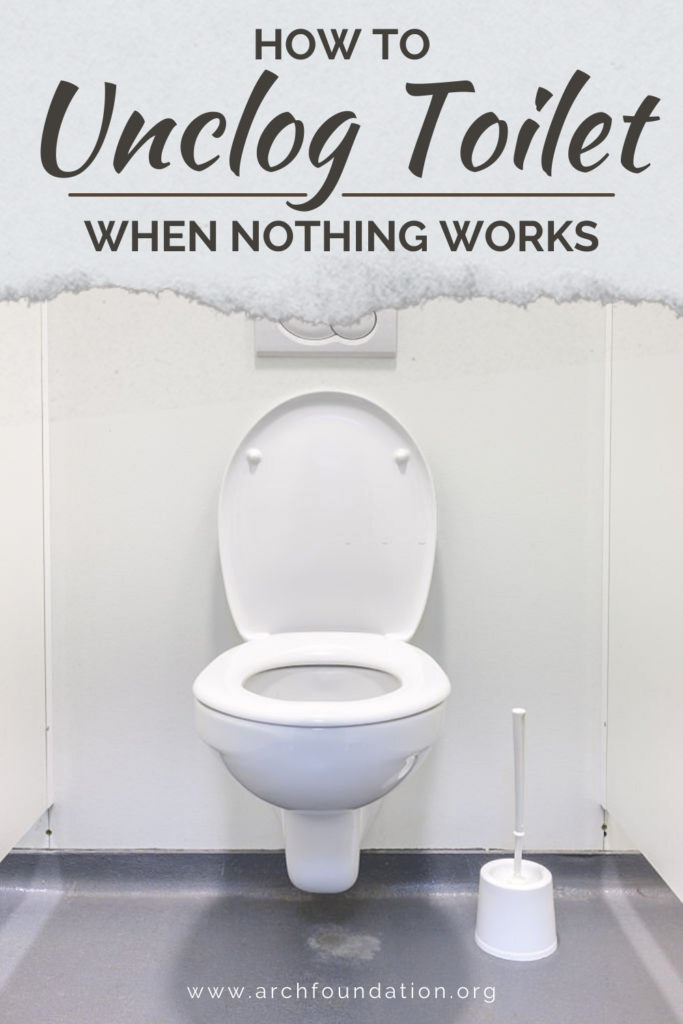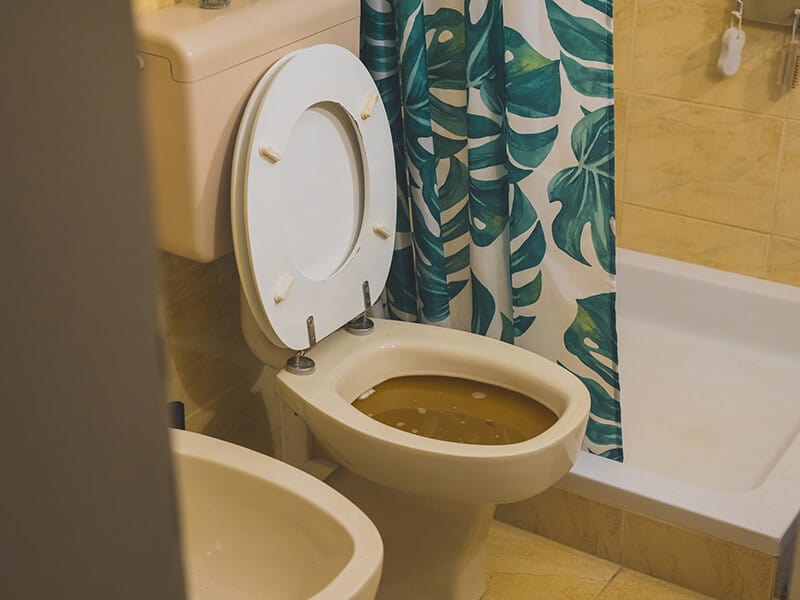How To Unclog Toilet When Nothing Works
How to unclog toilet when nothing works? I am here to help you find the best methods to unclog the toilet in all situations, using different things proven to help solve the toilet disaster.
Even though the unclogging toilet topic isn’t pretty, knowing how to do it is a skill that will always prove to be helpful. On top of my head, it will help you save money for expensive plumber services.
Toilet clogs for various reasons, and sometimes conventional methods such as using a plunger don’t work. So, what can you do? With the help of things you probably have around, such as vinegar or baking soda and a vacuum, you’ll soon put your toilet back in the business.
Here are the best hacks to unclog the toilet when you’ve tried everything!

Best Hacks To Unclog The Toilet When Nothing Works
You’ve probably tried the standard toilet unclogging things such as plunger and excessive flushing. If nothing you’ve tried so far didn’t work, it is time to try alternative methods of unclogging the toilet.
Here are things that will unclog your toilet:
- Wet and dry vacuum
- Wire hanger
- Baking soda and vinegar
- Dish soap and hot water
- Enzyme cleaner
- Snake tool
No plunger? No problem! Learn how to use a plastic bottle instead of a plunger.
Why Does The Toilet Keep Clogging?
There could be several reasons why your toilet keeps clogging. Don’t think you are unlucky, rather think about potential reasons that will help you prevent the toilet clogs next time.
Here are the most common reasons for toilet clogs.
Wrong Toilet Paper
Not all toilet papers are formulated the same way. Sometimes, toilet paper doesn’t dissolve the way it is supposed to dissolve. It piles up and acts as a solid item that clogs the pipes.
Additionally, the toilet paper quality might not be the issue. Do you use too much of it? If you use too much water, the toilet can easily clog. It is common in toilets in which the flush system isn’t very powerful.
Something Has Stuck
A common reason why many toilets clog is that something is blocking the pipes. It can be hygienic tampons, hygienic pads, toys, bottles of shampoo, or anything else.
If you have young children, the risks are higher because children are known to flush things that shouldn’t be flushed. Therefore, keep an eye on what you and your family have been flushing lately.
The Tank Doesn’t Hold Enough Water
If you have a poor water supply line, your toilet tank is affected, too. There might not be enough water in the tank, so the flush system loses power and cannot flush everything efficiently. Open the water supply knob fully and see if things improve.
Issues With Vents
Poorly designed venting pipes might result in a clogged drainage system. It is because the drainage system requires proper airflow to work as intended. The problem is more common in the old house with outdated pipes.
If nothing else works, you might have to contact a plumber to inspect the pipes and see what you can do to make your system more efficient.

Bad Toilet
There are various toilet designs on the market. Low-flush toilets, for example, might work well enough, but if you have accompanying issues such as the wrong paper design, your toilet will clog. Additionally, the angle of the bowl might be too small, so it reduces the flush system power.
If you want to replace your current toilet, read as many reviews as possible to find the toilet with maximum flush power and the most efficient design.
You’Re Using Hard Water
Hard water is water with high mineral content. After a while, minerals can deposit in the tank and drain pipes, which will affect both the flush system and drainage. The only solution is to replace the tank and pipes or invest in the water softening filters.
Additionally, chlorinated water might damage the rubber parts and seals in the toilet, which will reduce the flushing power.
6 Ways To Unclog The Toilet When Nothing Works
Let’s talk about not so pretty things – unclogging the toilet when nothing works. Don’t give up and call a plumber or use harsh chemicals just yet, there are a few things to try!
#1. Wet/Dry Vacuum
If you own a wet and dry vacuum cleaner, you can use it to unclog the toilet. It isn’t the prettiest method, but it is definitely one of the most effective methods for unclogging the toilet. The more powerful wet and dry vacuum you have, the better the results will be.
Put on rubber gloves and use a vacuum to suck the excess water. It will help remove tiny debris and organic waste. Once the bowl is empty, put the hose deeper into the hole. Stop when you feel resistance, as it means you reached the item that is clogging the toilet.
Turn the vacuum on the highest power and suck the clog. When it sucks the clog, test the toilet to see if water flows as it should. If you notice slow water flow, try some of the following methods.
#2. Dish Soap And Hot Water
Dish soap is very effective in dissolving dirt, grease, and organic waste. You’ll need hot but not boiling water and dish soap.
Pour a little dish soap into the toilet and slowly add one gallon of hot water to the bowl. Wait a couple of minutes so the mixture can dissolve the clog and flush the toilet.
If you notice the water goes away slowly, repeat the process but let the dish soap do its magic for longer. You can also use the wet and dry vacuum at this point to shorten the process.
Will a dishwasher table unclog your toilet? Find out in the video.
#3. Baking Soda And Vinegar
Baking soda and vinegar mixture works like a charm to dissolve hard water stains, mineral deposits, and various clogs, including the one in your toilet.
But, this method will work better if you are able to remove the wastewater from the bowl so the water won’t dilute the baking soda and vinegar mixture.
Pour a cup of baking soda into the toilet bowl and add the same amount of white vinegar. You should hear sizzling sounds as the two ingredients react. Once the sizzling stops, you can flush the toilet as regularly.
If you aren’t satisfied with the results, repeat the process but increase the amount of baking soda and vinegar. You can also leave the mixture in two bowls for a couple of hours, so baking soda and vinegar can dissolve the materials causing the clog.
You can also use baking soda and vinegar to unclog other things in your homes, such as a sink or bathtub, following the same procedure.
#4. Wire Hanger
If the plunger didn’t work, use an old wire hanger. You’ll have to loosen it and create a shape that can be used to unclog the toilet.
Straighten one side of the wire hanger to create something similar to a hook. I also recommend attaching the old cloth at the end of the wire to prevent the wire from scratching the bowl.
A scratched bowl is difficult to clean, as irregular surfaces attract more dirt. Use duct tape to secure the cloth or put a rubber band to keep it in place.
Put the gloves on and dive into the bowl with a wire hanger. Push the hanger into the drain as much as possible. Then, twist it and apply the front and back, left and right motions to help loosen the clog. Keep doing it until you notice water draining.
Push the wire hanger further and ensure that you clean any obstruction blocking the drain. Then flush the toilet, clean it and throw away the gloves and wire hanger.
If the water keeps moving slowly, it means that you’ve only pushed the clog further, and you’ll have to use something longer, such as a snake tool.
#5. Use A Snake Tool
A snake tool is a plumbing tool, used by both professional plumbers and people at home. If your toilet clogs easily, it is a good idea to have one at home. Snake tools aren’t expensive, and they are sometimes called closet augers. Their shape is similar to what you can make with the wire hanger, but it allows you to reach the drain further.
The snake tool is flexible and has a rubber coating to prevent scratching the bowl. For this method, you also need to wear gloves as you need to put your hand into the dirty water. Put one end of the tool as deep as possible in the toilet.
Push until you feel resistance, as it signals that you’ve reached the clog. Twist the handle repeatedly until you notice the tool starts to move without resistance. Flush the toilet, and put the snake tool one more time into the drain to ensure the entire clog is removed.
If the water keeps moving slowly, you can try the enzyme cleaner to dissolve the leftover clogs.
#6. Enzyme Cleaner
Enzyme-based cleaners also help dissolve the organic clogs. Most grocery stores have these types of products. Sometimes, they are intended for sink unclogging, but they will work fine with the toilet unclogging as well. However, you might have to use a larger amount.
You can also try the enzyme waste removal formulated for the septic systems. They will dissolve the waste without damaging the pipes. But, enzyme waste removal products only work if your toilet is clogged with organic waste or toilet paper.
These won’t work if you have a solid item such as a toy, blocking the drainage. The process is simple.
Check the instructions to see what the recommended amount is for unclogging the toilet. Pour it into the toilet and let it work for ten minutes. The enzymes should soften the clog and open the drainage system so the water can flush easily.
Once the flush starts to work, flush the toilet. Then pour a small amount on the enzyme product one more time to ensure no waste is left in the toilet.
Watch this video to know more:
How To Maintain Your Toilet To Prevent Clogging?
Have you finally managed to unclog the toilet? Congratulations! But, now is the time to learn what things to do to prevent the toilet from clogging again. Proper and frequent flushing is the number one thing that will keep your toilet unclogged, but here are additional things to try.
Double-Flush
Flush the toilet once to remove the waste, and then flush it the second time to remove the toilet paper. It is especially useful if your toilet has low flushing power.
Use Waste Removal Products Occasionally
Don’t wait for the toilet to clog to try waste removal products. Use them as part of your regular toilet cleaning routine. You can pour a small amount of enzyme cleaner every time you clean the toilet to break even the smallest blockage.
I don’t recommend using chemical drain cleaners, as those may damage your pipes.
React In Time
If you notice a weak flush, it is a safe sign that a blockage might happen soon. It is easier to unclog a partially clogged toilet with a slow drain, than the toilet that has been completely clogged.
Be Mindful What You Flush
Talk with your family members about what they flush. Tampons, napkins, sanitary pads, large amounts of toilet paper, empty bottles, and Q-Tips are a big No-No for toilets. Put a small trash bin near the toilet, so you can safely dispose of waste.
Frequently Asked Questions
Do you have more questions about DIY toilet unclogging? Try to find the answers in the next section.
No Worst Case Scenarios With The Best Toilet Hacks
Unclogging the toilet on your own is a filthy task, but it is manageable. If you skip the plumber and methods I recommended, you’ll save a lot of money. Some methods aren’t that gross, such as pouring enzyme cleaner or using baking soda and vinegar.
Don’t be afraid to mix methods, to try to solve the problem. Let me know if you have more questions about toilet unclogging hacks!
Keep me posted on how these hacks worked for you!
Please consider sharing the article with your friends and family!

References:
- How to Treat Calcium Buildup in Toilet Pipes | DIY Plumbing Repairs. Plumber in Kingman, AZ | Plumbing By Jake. https://www.plumbingbyjake.com/blog/how-do-you-treat-calcium-buildup-in-toilet-pipes/.
- 18 Types of Toilets, Styles and Toilet Mechanisms [Full Guide]. My Plumber. https://my-plumber.co.uk/blog/types-of-toilets/.
- How to Keep Your Toilet Drain Clean – Cardinal Heating & Air Conditioning. Cardinal Heating & Air Conditioning. https://www.cardinalhvac.com/press-releases/how-to-keep-your-toilet-drain-clean/.

